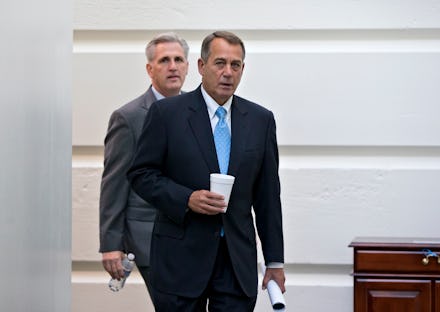How Much Do Government Shutdowns Cost Us? Since 2010, More Than You Know

Congress is an easy target for ridicule, especially when it is bargaining away the full faith and credit of the United States in exchange for defunding Obamacare, getting rid of the medical device tax, delaying the individual mandate, and cutting salaries for itself and its staff. The now 16-day shutdown has not amounted to anything more than a spectacle for constituents to sit back and watch their representatives argue along party lines regarding the size and role of government. The debate sounds big and ideological, but nothing substantial will change as a result of it.
As the Senate goes to vote at around 3 p.m. today on a deal to open the government back up and avoid a voluntary default on our sovereign debt (please note: a voluntary default), it is easy to laugh at the ineptitude of our elected leaders and write this episode off as more of the same from Washington.
Except it’s not funny, and in fact, has cost Americans two things needed coming out of a bad recession: economic growth and jobs.
A report released yesterday from Macroeconomic Advisers, a consulting firm, argues that a “divided government has failed to address long-run problems, instead encouraging policy that is short-sighted, arbitrary, and driven by calendar-based crises.” The effect has been, in Macroeconomic Advisers’ estimation, a loss of 1% of annual GDP growth and over two million jobs since the fourth quarter of 2010. Let’s break this down.
Fiscal policy is set by Congress each year by its decisions to tax and spend in two forms, mandatory (by law) and discretionary (by appropriations). Current fiscal policy will become unsustainable in 30 or more years, given that projections of future tax revenues will not match the future mandatory obligations owed to recipients of Social Security and health care, largely due to an aging population. At the same time, current law has discretionary spending falling from 8% of GDP in 2012 to just over 5% by 2023, the lowest level in 50 years. The problem is, as Macroeconomic Advisers writes, “not the immediate size of government but rather the unfunded promises of future entitlements.” The issue is long-term.
So Congress's solution, clearly, is structural reform to Social Security and Medicare with an overhaul of the tax system, all to be phased in over time to reduce short-term drag on the economy, right?
Wrong.
Congress has instead decided that it will continue to slash discretionary spending now (read: infrastructure, research and development, education, etc.), and add uncertainty to financial markets by bargaining with the debt ceiling once every six months (interesting, given that Treasury bonds serve as the risk-free collateral in almost all global markets). Macroeconomic Advisers runs a “counterfactual” simulation (i.e. what would have happened) had Congress been less myopic in its negotiations since 2010. The effect, as noted above, is a loss of 0.7% in annual GDP growth and 1.2 million jobs due to poor tax and spending decisions, and a loss of 0.3% in annual GDP growth and 900,000 jobs due to added economic uncertainty.
More importantly, nothing has been legislated on long-term entitlement programs. Congress has worried too much about short-term levels of debt and deficits, and not enough on jobs and growth, ignoring the long run entirely. The result is that we are still exposed to the potential problems with Social Security and Medicare 30 years from now, but find ourselves in a worse position today than if Congress had acted with flexibility and coordination in battling the recent recession.
Today’s vote to raise the debt ceiling is the right thing to do, because voting no is just stupid. Assuming the vote does indeed pass and we avoid a sovereign default, the question becomes, given that the costs of fiscal policies have been quantified, will Congress back off ideological lines and work together to address the country’s problems in a meaningful way, both in the short and long run?
Better late than never.